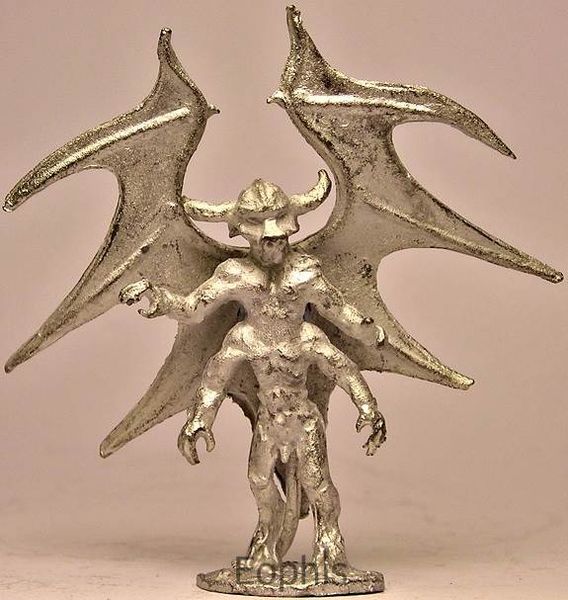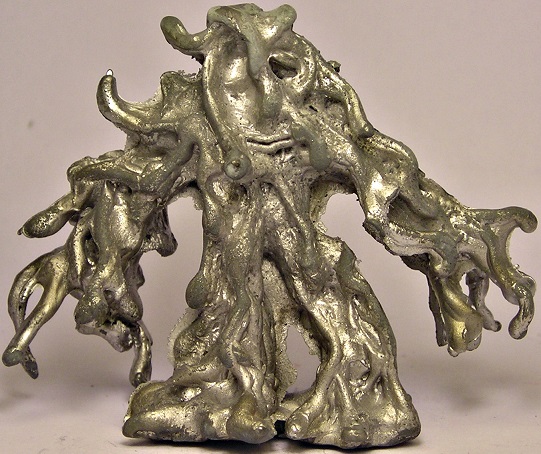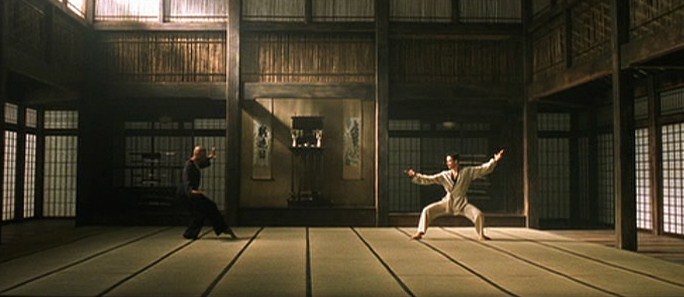LET THERE BE A METHOD TO YOUR MADNESS
by Richard Gilbert
WHEN DESIGNING A DUNGEON; before you begin madly scattering chutes, monsters, and secret doors, take a moment to figure out what it's all for. If you are postulating a world with any sort of "realizm" [sic] at all, you must appreciate that a dungeon doesn't just come into being for the hell of it. to the peoples of your world, digging a dungeon out of solid rock is a tremendous task, one not to be undertaken lightly.
Compared to the philosophy of the
Tomb of Horrors, or Gygax literally rolling a dungeon from random tables behind the screen as the PCs look on, this is almost shockingly revolutionary thinking. Gilbert illustrates this with a mind's-eye sketch of a 15-level dungeon for a wizard named Nappo which at its peak included barracks and facilities for several hundred orcs...which probably never made it any farther than that planning stage. It's not a bad article, although I didn't get this reference:
A D&D world does not have to be similar to Europe, as Dr. Barker has shown us so well.
It turns out that Gilber was referencing the creator of
Tekumel.
THE PLAY'S THE THING...
by Thomas Filmore
When you roll up your next character, try investing more in him than just the six die rolls. Try to create a colorful background for him. give him a purpose and a reason for being where and what he is.
Filmore trying to encourage role-playing versus roll-playing. The focus on making an
interesting character instead of a merely
powerful one is not something we associate with early D&D, but it was obviously an issue that some players felt the need to address. It really is funny how long ago some of these issues came up, and how relevant they remain.
So, personalize your next character, play the part of a saint or demon, vary your characters as much as possible to experience the range of excitement available in the worlds of D + D.
DESIGNING FOR UNIQUE WILDERNESS ENCOUNTERS
by Daniel Clifton
As much as we talk about "points of light," early D&D really was about dungeon-crawling, and wilderness is what you passed through to get to the dungeon, rolling random encounters like this was walking through the Mirkwood in the Hobbit and all the dwarfs had strayed off the path. This article consists of a set of random tables and associated directions on how to use them. The second paragraph starts off with:
For encounters, consider a four foot square area and determine terrain to each corner section of four square feet. If a river flows through the hex in question, then allow a 105 chance that it will flow across the field with an additional 10% chance that it will have a ford (if an encounter with a swimmer is indicated, then the river will always be on the field; and if the party is travelling upon a road, then an appropriate bridge or ford will be located at the river.) To determine the course of the river, first randomly locate it in one of the areas, find the initial direction of flow in chart 6-A, and then plot its course according to chat 6-B from one four-square-foot area to the next until both ends are plotted off the field. roll on the appropriate chart for each area, plotting the flow of streams as with rivers immediately upon rolling the proper number. Next, find the grade of slopes and hills by rolling on the matching 'A' chart (grade also indicates height [...]
...you get the idea. After you sit the maths exam, you may have a richly detailed cartographic wilderness experience, but I doubt it.
DESERTED CITIES OF MARS
by Jim Ward
Thoughts on adapting Edgar Rice Burrough's description of Martian ruins into D&D. There are, of course, tables.
The Martian architecture lends itself easily to chart form, which may prove useful to the perspective [sic] judge.
I'd like to take half a moment to add that most of these "articles" are incredibly short by contemporary standards - half a page or a page is typical - probably because these were written back when you still had to type stuff and lay things out by hand.
THE TOAL PERSON IN METAMORPHOSIS ALPHA
by James M. Ward
The concept of role playing revolves around the idea that you become a "being" from a world that can only be imagined.
This takes the central thesis of Filmore's article above, and decides that what you
really want are a series of tables to roll on to fill out your backstory, as determined by your trusty dice. This includes a Mutation Generation Chart which determines how many generations of mutation there are for each of your parents (from "Human" to "Tenth Generation Mutant"). I don't know what it gets you to be the proud descendant of ten generations of mutation on both sides (aside from a number of physical and mental defects), but you roll your dice and take your chances.
HOW HEAVY IS MY GIANT?
by Shlump da Orc
Einshtein, our smartest Kobold, based his formula on an average human male, 5'8" tall with a 38" chest size, and 18" torso length and who weighs 180 lbs. Then he figured that this portion of the body amounts to 35% of the whole body. THrough diabolical methods he discovered that a cubic foot of a human body weighs 47 lbs. Using all of this information he created a formula and calculated the following weights, chest sizes and torso lengths.
Written in character, this is basically a set-up for a height/weight chart that goes from 5'8" (which the table actually lists as 160 lbs) to 30' (23,660 lbs). This is then complicated on the next page by discussing over- and under-weight giants, the refined formula, a discussion of how much a giant could lift based on their weight (not related to their Strength attribute), and "non-flesh giants" for when you have giant animated bronze statues; also the length of giant strides. The list of pounds-per-cubic-foot weights of various substances (just in case you absolutely needed a giant Aluminum Golem in your dungeon) is so long that they had to continue it on page 41.
Which is...uh...fucking nerdy, but the kind of shit you have wikipedia and probably an app for today, if you even care that much about the relative weight of fictional giants who probably couldn't support their own mass unassisted anyway.
TOLKIEN IN DUNGEONS & DRAGONS
by Rob Kuntz
Many people who play and enjoy D&D still have their complaints to offer TSR in one form or the other. One which crops up persistently is the comparison issue between Dungeons and Dragons and that of J. R. R. Tolkien's works. Some people get to the crux of the matter by stating the obvious disagreements between Tolkien's conceptions and fictional characters as compared to their representation within the D&D game format.
Frank and I discussed this a bit when we did the OSSR of
MERP, but the number of gamers that were
really upset about not being able to roleplay in Middle Earth was directly contrasted by the lawyers for the Tolkien estate, who wanted royalties per hobbit or something.
The funniest part of this article isn't Kuntz' vapid attempt to argue that D&D wasn't designed to
steal from emulate Tolkien, but the snippets of fan-letters that he copies into the body of his article where people bitch that
elves don't get enough dice. But Kuntz does at least note:
One must also remember that this system works with the worlds of r. E. Howard, Fritz Leiber and L.S. de Camp and Fletcher Pratt much better than that of Tolkien.
Which is patently true. Kuntz also notes that:
THere was not a continuing story line possible, for the story itself was in fact based around the destruction of the ring and all those events which were spawned from it. As we would say at TSR "END OF ADVENTURE"
Curtain, fade to black.
NOTES FROM A SEMI-SUCCESSFUL D&D PLAYER
by James Ward
I like that this article shares space with a full-column advertisement for the
ARDUIN TRILOGY, which most people have fucking forgotten about and good riddance. Also, I wonder if absolutely any of the people that wrote these articles were ever paid for them - I kinda doubt it. But I digress.
This is Jim Ward's bag of adventurer hacks, like creating a
continual light wand instead of a torch (not an actual
wand wand, but a small baton like a perpetual glowstick); carrying around a small potted rose plant, a
potion of plant control, and a 4th-level plant/growth spell just in case you get cornered in the dungeon; steel potion bottles to prevent breakage; carry around vials of garlic juice to hurl at vampires that are standing outside of normal garlic-smelling range...and others.
Everyone knows the usefulness of the ten foot pole in many tight places. The use of a five foot steel rod is even more useful in those tight places.

Then there is the poison on the dagger trick, which every judge is always trying to stop. I have been told that poisons evaporate, poisons exposed to the air lose their effectiveness, or the most used of all, in your area there is no poison strong enough to kill the things you want. I suggest to all you players and especially the magic users that can use only daggers, that any amount of money and effort spent in the procuring of a really effective poison is worth it. I spent over 90,000 gold and haven't regretted a copper piece of it.
What a coincidence.
Now, some of these are silly and some of them are sound, and I personally like the idea of researching original spells ("I made a fourth level cold ray that really works great against all creatures and especially those fire types."), even though D&D was notoriously bad at providing actual mechanics for that. However, Jim adds at the end:
Hope some of this helps, those ever suffering players, in the dungeons where the judge is a real sadist!
SOME THOUGHTS ON THE SPEED OF A LIGHTNING BOLT
by James Ward
This article was inspired by the release of
Eldritch Wizardry and is the effective equivalent of asking how Captain Kirk can dodge phaser blasts, except Jim is sympathetic with how the poor wizard can deal with those "Conan-type" fighters with all those damn hit points. I'm really not sure how to approach this article, given how completely tone-deaf it seems to be...warriors and wizards, steel vs. spells at 40 feet apart.
THE MEANING OF LAW AND CHAOS IN DUNGEONS & DRAGONS AND THEIR RELATIONSHIPS TO GOOD AND EVIL
by Gary Gygax
This is in part a definition of what "Law" and "Chaos" mean with regard to the D&D alignment axis, and includes a rather large Cartesian plotmap that has Law - Chaos on the horizontal axis, Good - Evil on the vertical axis, a box for Neutrality in the middle, and fits most of the critters from the Monster Manual in it for a slightly more complicated positioning system than we normally think of alignment being. Actually, this wouldn't be the stupidest approach if they made some sort of Japanese TRPG-style power graphic out of it. So, for example, white dragons are just on the evil side of true neutral, while brass dragons are just on the good side of chaotic.
The most interesting thing about this article is that it represents an evolution of Gygax's thinking but not a shift in his position:
Many questions continue to arise regarding what constitutes a "lawful" act, what sort of behavior is "chaotic", what constituted an "evil" deed, and how certain behavior is "good". There is considerable confusion in that most dungeon-masters construe the terms "chaotic" and "Evil" to mean the same thing, just as they define "lawful" and "good" to mean the same This is scarcely surprising considering the wording of the three original volumes of DUNGEONS & DRAGONS. When that was written they meant just about the same thing in my mind--notice I do not say they were synonymous in my thinking at that time. The wording in the GREYHAWK supplement added a bit more confusion, for by the time that booklet was written some substantial differences had been determined. In fact, had I the opportunity to do D&D over I would have made the whole business very much clearer by differentiating the four categories, and many chaotic creatures would be good, while many lawful creatures would be evil.
This is, recognizably, what Gygax ultimately did do in D&D.
As a final note, most of humanity falls into the lawful category, and most of lawful humanity lies near the line between good and evil. With proper leadership the majority will be prone towards lawful/good. few humans are chaotic, and very are chaotic and evil.
GARY GYGAX ON DUNGEONS & DRAGONS Origins of the Game
When the International Federation fo Wargaming was at its peak, it contained many special interest groups. I founded one of these, the "Castle 7 Crusade Society". All members of this sub-group were interested in things medieval and I began publishing a magazine for them entitled Domesday Book. In an early issue, I drew up a map of the "Great Kingdom". Members of the society could then establish their holdings on the map, and we planned to sponsor campaign-type gaming at some point. Dave Arneson was a member of the C&C Society, and he established a barony, Blackmoor, to the northeast of the map, just above the Great Kingdom. He began a local medieval campaign for the Twin cities games and used this area.
...and on into the creation of CHAINMAIL, the beginning of the Greyhawk campaign, and then D&D. It's a pretty brief article and more-or-less accurate, although I think Arneson's contributions are not as emphasized as they should be.
Although D&D was not Dave's game system by any form or measure, he was given co-billing as author for his valuable idea kernels. He complained bitterly that the game wasn't right, but the other readers/players loved it.
Pull the other one Gary, it has got bells on.
You can, however, rest assured that work on a complete revision of the game is in progress, and I promise a far better product.
D&D IS ONLY AS GOOD AS THE DM
by Gary Gygax
Successful play of D&D is a blend of desire, skill, and luck.
DM advise from Gygax, which ranges from "well, that sounds reasonable" to
[...] if a favorite player stupidly puts himself into a situation where he is about to be killed, let the dice tell the story and KILL him.

Player character life was cheap in the early dungeons. Gary also bitches heavily about players that deign to spend six months in-character enchanting swords or researching spells or things like that. And, something Frank might relate to:
Now I know of the games played at CalTech where the rules have been expanded and changed to reflect incredibly high levels, comic book characters and spells, and so on. Okay. Different strokes for different folks, but that is not D&D. While D&D is pretty flexible, that sort of thing stretches it too far, and the boys out there are playing something entirely different - perhaps their own name "Dungeons & Beavers," tells it best.
Gygax also asserts:
To my certain knowledge no player in either BLACKMOOR or GREYHAWK has risen above 14th level.
The point of this early-life-crisis old-manning is that players aren't
earning their rewards...but he also suggests you don't go too far "the other way":
so if a 33rd level wizard reflects a poorly managed campaign, a continuing mortality rate of 50% per expedition generally reflects over-reaction and likewise a poorly managed campaign. It is unreasonable to place three blue dragons on the first dungeon level, just as unreasonable as it is to allow a 10th level fighter to rampage through the upper levels of a dungeon rousting kobolds and giant rats to gain easy loot and experience.
Which still shows how limited Gygax's thinking was at this point - still focused on the descent through levels of a dungeon, getting harder the deeper you go. Not a very organic approach, although AD&D would end up being very organic indeed.
And we'll leave it there for now. More delving into the time capsule next time.















